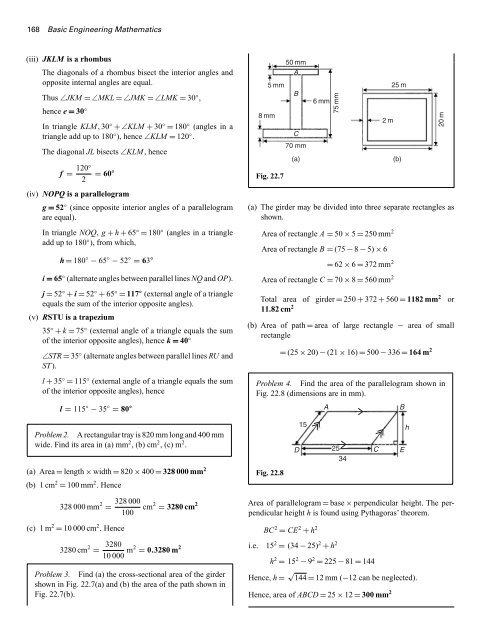basic_engineering_mathematics0
You also want an ePaper? Increase the reach of your titles
YUMPU automatically turns print PDFs into web optimized ePapers that Google loves.
168 Basic Engineering Mathematics<br />
(iii) JKLM is a rhombus<br />
The diagonals of a rhombus bisect the interior angles and<br />
opposite internal angles are equal.<br />
Thus ∠JKM = ∠MKL = ∠JMK = ∠LMK = 30 ◦ ,<br />
hence e = 30 ◦<br />
In triangle KLM,30 ◦ + ∠KLM + 30 ◦ = 180 ◦ (angles in a<br />
triangle add up to 180 ◦ ), hence ∠KLM = 120 ◦ .<br />
The diagonal JL bisects ∠KLM, hence<br />
f = 120◦<br />
2<br />
= 60 ◦<br />
(iv) NOPQ is a parallelogram<br />
g = 52 ◦ (since opposite interior angles of a parallelogram<br />
are equal).<br />
In triangle NOQ, g + h + 65 ◦ = 180 ◦ (angles in a triangle<br />
add up to 180 ◦ ), from which,<br />
h = 180 ◦ − 65 ◦ − 52 ◦ = 63 ◦<br />
i = 65 ◦ (alternate angles between parallel lines NQ and OP).<br />
j = 52 ◦ + i = 52 ◦ + 65 ◦ = 117 ◦ (external angle of a triangle<br />
equals the sum of the interior opposite angles).<br />
(v) RSTU is a trapezium<br />
35 ◦ + k = 75 ◦ (external angle of a triangle equals the sum<br />
of the interior opposite angles), hence k = 40 ◦<br />
∠STR = 35 ◦ (alternate angles between parallel lines RU and<br />
ST).<br />
l + 35 ◦ = 115 ◦ (external angle of a triangle equals the sum<br />
of the interior opposite angles), hence<br />
l = 115 ◦ − 35 ◦ = 80 ◦<br />
8mm<br />
5mm<br />
Fig. 22.7<br />
50 mm<br />
A<br />
B<br />
C<br />
70 mm<br />
(a)<br />
6mm<br />
75 mm<br />
2m<br />
25 m<br />
(a) The girder may be divided into three separate rectangles as<br />
shown.<br />
Area of rectangle A = 50 × 5 = 250 mm 2<br />
Area of rectangle B = (75 − 8 − 5) × 6<br />
= 62 × 6 = 372 mm 2<br />
Area of rectangle C = 70 × 8 = 560 mm 2<br />
Total area of girder = 250 + 372 + 560 = 1182 mm 2 or<br />
11.82 cm 2<br />
(b) Area of path = area of large rectangle − area of small<br />
rectangle<br />
(b)<br />
= (25 × 20) − (21 × 16) = 500 − 336 = 164 m 2<br />
Problem 4. Find the area of the parallelogram shown in<br />
Fig. 22.8 (dimensions are in mm).<br />
A<br />
B<br />
20 m<br />
Problem 2. A rectangular tray is 820 mm long and 400 mm<br />
wide. Find its area in (a) mm 2 , (b) cm 2 , (c) m 2 .<br />
(a) Area = length × width = 820 × 400 = 328 000 mm 2<br />
(b) 1 cm 2 = 100 mm 2 . Hence<br />
Fig. 22.8<br />
15<br />
h<br />
D 25 C E<br />
34<br />
328 000 mm 2 =<br />
(c) 1 m 2 = 10 000 cm 2 . Hence<br />
328 000<br />
100<br />
cm 2 = 3280 cm 2<br />
3280 cm 2 = 3280<br />
10 000 m2 = 0.3280 m 2<br />
Problem 3. Find (a) the cross-sectional area of the girder<br />
shown in Fig. 22.7(a) and (b) the area of the path shown in<br />
Fig. 22.7(b).<br />
Area of parallelogram = base × perpendicular height. The perpendicular<br />
height h is found using Pythagoras’ theorem.<br />
BC 2 = CE 2 + h 2<br />
i.e. 15 2 = (34 − 25) 2 + h 2<br />
h 2 = 15 2 − 9 2 = 225 − 81 = 144<br />
Hence, h = √ 144 = 12 mm (−12 can be neglected).<br />
Hence, area of ABCD = 25 × 12 = 300 mm 2















![[Lonely Planet] Sri Lanka](https://img.yumpu.com/59845622/1/169x260/lonely-planet-sri-lanka.jpg?quality=85)

